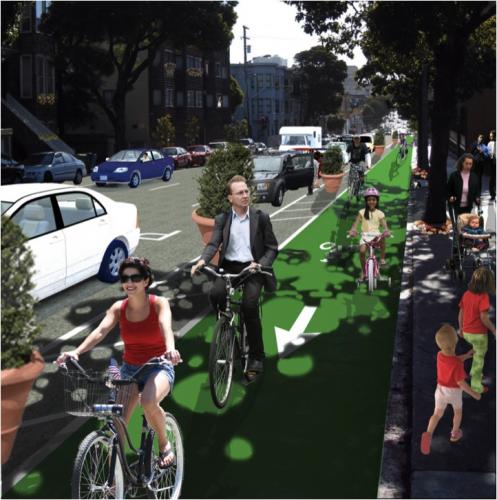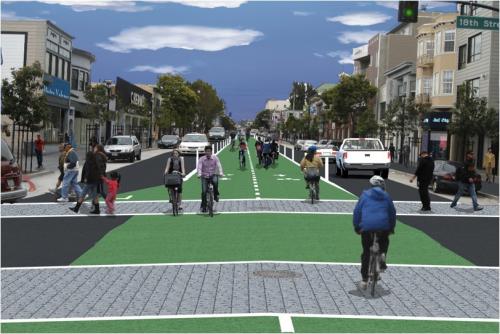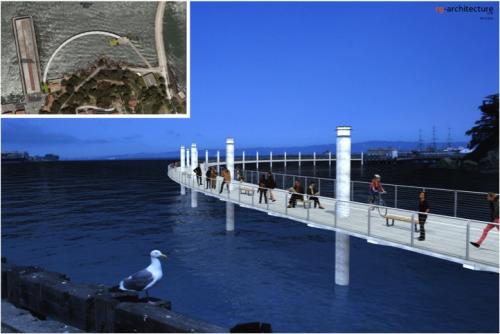
What would it take to transform San Francisco into a world-class bicycling city? More bike racks? More designated green lanes? Fewer hills? San Francisco is already one of the premiere biking cities in the country: bicycling has increased over 50% since 2006, and last year saw over 8,000 bicyclists on the city's streets. San Francisco was recently ranked the sixth most bike-friendly city in America.
But most San Francisco residents are not riding their bicycles. Last week's lunch forum, "Crosstown bikeways," hosted by Andy Thornley and Renee Rivera of the San Francisco Bicycle Coalition, posed the question: "What is it going to take to get your neighbors, boss, coworkers and in-laws to ride bikes?"
The SF Bicycle Coalition publicly debuted its "Connecting the City" campaign at SPUR last week, featuring routes that would allow residents to cross the entire city by bike. Borrowing a slogan from Gil Peñalosa, the visionary livable city advocate (as well as former Parks Commissioner of Bogotá, Colombia), Rivera and Thornley spoke of improving the city's bike network to make bicycling across town a real possibility for citizens aged "eight to 80."
Appealing to families, senior citizens and children, (not necessarily the dominant demographic in urban bicycling), the SF Bicycle Coalition made a strong case for creating new bikeways and elevating the existing routes with improvements like green paint and soft barriers against traffic. As Thornley pointed out regarding the overwhelming enthusiasm for Market Street's new experimental green lanes, "a little bit of space designation goes a long way."
Among the proposed priority bikeways are the "Bay to the Beach" route, extending from the Ferry Building, continuing down Market Street, through Golden Gate Park to the coast, and the "Bay Trail," which extends around the entire shoreline from Hunters Point to the Presidio.
A suggested improvement of the Valencia Street bike lane would move the lanes from the curbsides to the middle of the street, allowing bicyclists to avoid idling vehicles and other obstacles. The Coalition also proposed a bridge extending around Black Point in Fort Mason, so that bicyclists and pedestrians alike could avoid climbing the steep hills there.
But perhaps most essential to the Connecting the City campaign is its vision of a bike network as a multi-layered system that includes transit, pedestrians, and even cars. A representative from the SFMTA cited the need to "get out of the bikes versus cars talk" and "reframe the debate" as necessary for pushing through a city-spanning bike network. Most car advocates probably haven't considered that more bicycling means fewer cars on the road — and less traffic.
Although the SFMTA voted to adopt the 2009 San Francisco Bike Plan, a five-year master plan adding 34 miles of new lanes and 60 overall improvement projects, the Connecting the City campaign focuses on routes that would allow San Franciscans to bike from one end of the city to the other.
By next year the San Francisco Bicycle Coalition hopes to make three miles of "eight to 80" bike lanes available to the citizens of San Francisco, with the entire crosstown route completed by 2012, and 10% of trips in the city made by bicycle.

A rendering of proposed bike lanes down the middle of Valencia Street.

A bridge for bicyclists and pedestrians around Black Point.
[All images via San Francisco Bicycle Coalition]